|
|
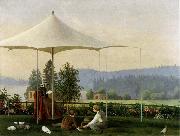 |
Ferdinand von Wright
|
|
1822-1906,Brother of Magnus von Wright and Wilhelm von Wright. He grew up under the influence of his brothers and became a skilled ornithological illustrator at a very young age. He remained in Sweden from 1837 until 1844 and worked as a draughtsman, helping his brother Wilhelm. After returning to Finland he set his sights on a career as a painter. During the second half of the 1840s he was still searching for his proper path, and he experimented with a number of subjects: birds, still-lifes, landscapes and portraits. |
|
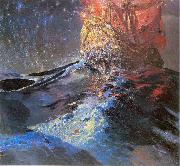 |
Ferdynand Ruszczyc
|
|
(1870-1936) was a Polish painter, printmaker, and stage designer. Ruszczyc originally studied law at the University of St. Petersburg, but then switched majors and began taking painting classes at the Academy of Fine Art. He was a student of famous Russian landscape painters Ivan Shishkin and Arkhip Kuindzhi. Ruszczyc travelled to the Crimea to paint seascapes, and later to the Baltic islands and Sweden to paint northern landscapes. He visited Berlin, where he was significantly influenced by the Symbolist painters such as Arnold Bocklin. After graduation, Ruszczyc made extensive tours of Western Europe incorporating much of the styles he came across into his own art. |
|
|
|
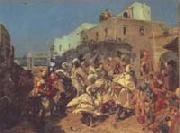 |
Fernand cormon
|
|
French Academic Painter, 1845-1924
French painter. He studied initially in Brussels under Jean-Fran?ois Portaels. In 1863 he returned to Paris, where for three years he was a pupil of Alexandre Cabanel and Eug?ne Fromentin. He made his d?but at the Salon in 1868 and in 1870 received a medal for the Marriage of the Niebelungen (1870; ex-Mus. B.-A., Lisieux, 1970). His painting the Death of King Ravana (1875; Toulouse, Mus. Augustins), taken from the Indian epic poem the Ramayana, was criticized for the choice of an obscure subject but was nevertheless awarded the Prix de Salon in 1875. Soon afterwards Cormon left France for Tunisia. After his return in 1877 he exhibited regularly at the Salon until his death, establishing a reputation as a painter of historical and religious subjects; he also produced some portraits. |
|
|
|
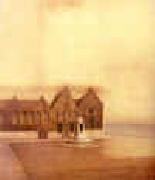 |
Fernand Khnopff
|
|
1858-1921 Belgian Fernand Khnopff Gallery Fernand Khnopff was born to a wealthy family that was part of the high bourgeoisie for generations. Khnopff's ancestors had lived in Flanders since the early 17th-century but were of Austrian and Portuguese descent. Most male members of his family had been lawyers or judges, and young Fernand was destined for a juridical career. In his early childhood (1859-1864) he lived in Bruges where his father was appointed Substitut Du Procureur Du Roi. His childhood memories of the medieval city of Bruges would play a significant role in his later work. In 1864 the family moved to Brussels. To please his parents he went to law school at the Free University of Brussels (now divided into the Universite Libre de Bruxelles and the Vrije Universiteit Brussel) when he was 18 years old. During this period he developed a passion for literature, discovering the works of Baudelaire, Flaubert, Leconte de Lisle and other mostly French authors. With his younger brother Georges Khnopff - also a passionate amateur of contemporary music and poetry - he started to frequent Jeune Belgique ("Young Belgium"), a group of young writers including Max Waller, Georges Rodenbach, Iwan Gilkin and Emile Verhaeren. Khnopff left University due to a lack of interest in his law studies and began to frequent the studio of Xavier Mellery, who made him familiar with the art of painting. On the 25th of October 1876 he enrolled for the Cours De Dessin Apres Nature ("course of drawing after nature") at the Academie Royale des Beaux-Arts en Bruxelles. At the Academie, his most famous fellow student was James Ensor, whom he disliked from the start. Between 1877 and 1880 Khnopff made several trips to Paris where he discovered the work of Delacroix, Ingres, Moreau and Stevens. At the Paris World Fair of 1878 he became acquainted with the oeuvre of Millais and Burne-Jones. During his last year at the Acad??mie in 1878-1879 he neglected his classes in Brussels and lived for a while in Passy, were he visited the Cours Libres of Jules Joseph Lefebvre at the Acad??mie Julian. |
|
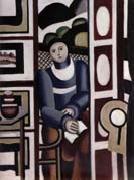 |
Fernand Leger
|
|
French Cubist Painter, 1881-1955,was a French painter, sculptor, and filmmaker,Leger was born in the Argentan, Orne, Basse-Normandie, where his father raised cattle. Fernand Leger initially trained as an architect from 1897-1899 before moving in 1900 to Paris, where he supported himself as an architectural draftsman. After military service in Versailles in 1902-1903, he enrolled at the School of Decorative Arts; he also applied to the Ecole des Beaux-Arts but was rejected. He nevertheless attended the Beaux-Arts as a non-enrolled student, spending what he described as "three empty and useless years" studying with Gerome and others, while also studying at the Academie Julian. He began to work seriously as a painter only at the age of 25. At this point his work showed the influence of Impressionism, as seen in Le Jardin de ma mere (My Mother's Garden) of 1905, one of the few paintings from this period that he did not later destroy. A new emphasis on drawing and geometry appeared in Leger's work after he saw the Cezanne retrospective at the Salon d'Automne in 1907. In 1909 he moved to Montparnasse and met such leaders of the avant-garde as Archipenko, Lipchitz, Chagall, and Robert Delaunay. His major painting of this period is Nudes in the Forest (1909-10), in which Leger displayed a personal form of Cubism??his critics called it "Tubism" for its emphasis on cylindrical formsethat made no use of the collage technique pioneered by Braque and Picasso. In 1910 he joined with several other artists, including Delaunay, Jacques Villon, Henri Le Fauconnier, Albert Gleizes, Francis Picabia, and Marie Laurencin to form an offshoot of the Cubist movement, the Puteaux Group??also called the Section d'Or (The Golden Section). Leger was influenced during this time by Italian Futurism, and his paintings, from then until 1914, became increasingly abstract. Their vocabulary of tubular, conical, and cubed forms are laconically rendered in rough patches of primary colours plus green, black and white, as seen in the series of paintings with the title Contrasting Forms. Leger's experiences in World War I had a significant effect on his work. Mobilized in August 1914 for service in the French Army, he spent two years at the front in Argonne. He produced many sketches of artillery pieces, airplanes, and fellow soldiers while in the trenches, and painted Soldier with a Pipe (1916) while on furlough. In September 1916 he almost died after a mustard gas attack by the German troops at Verdun. |
|
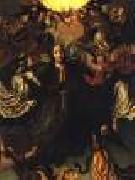 |
FERNANDES, Vasco
|
|
Portuguese painter (active 1500-1542 in Viseu)
Portuguese painter. He was the leading painter of northern Portugal during the first half of the 16th century, and it is probable that he received his training abroad. Fernandes is the best-documented Portuguese artist of the period; there are nearly 100 works attributed to him, some of which are securely documented and record his activity either alone or in collaboration with the Viseu painter GASPAR VAZ. Fernandes's most important work was carried out in Lamego and in Viseu, where the term Gr?o ('Great') used in praise of him is first recorded (Ribeiro Botelho Pereira). In 1753 the Director of the Dresden Gallery, Pietro Guarienti, first used the epithet when he referred to Fernandes by the name of Gran Vasco. The many myths about the painter and his work developed from this date and were not clarified until 1846 |
|
 |
Fernando Gallego
|
|
1466-1507
Spanish
Fernando Gallego Galleries
was a Spanish painter, his art is regarded as a gothic style. It is thought that he was born in Salamanca, Spain, an his first knowned works were in the cathedrals of Plasencia and Coria, in Caceres (Spain). His most famous knowned works are:
The Retablo of San Ildefonso, in the Cathedral of Zamora
The Sky of Salamanca, in the University of Salamanca.
The retablo of Ciudad Rodrigo, now in the Tucson Museum, University of Arizona, USA.
The Arcenillas panels, placed in Zamora.
San Acacio and the 10,000 Martyrs, at the Meadows Museum.
The last time that he was named in a document is in 1507, but we do not know the date of the death. |
|
|
|
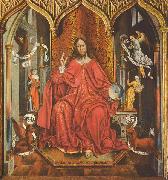 |
Fernando Gallego
|
|
(c. 1440 - 1507) was a Spanish painter, brought up in an age of gothic style, his art is generally regarded as Hispano-Flemish style. It's thought that he was born in Salamanca, Spain, and his first known works were in the cathedrals of Plasencia and Coria, in Ceres (Spain). |
|
|
|
|
|
|
|
|
|
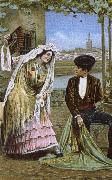 |
ferruccio busoni
|
|
Period: Modern (1910-1949)
Country: Italy
Born: April 01, 1866 in Empoli, Italy
Died: July 27, 1924 in Berlin, Germany
Genres: Chamber Music, Concerto, Keyboard Music, Opera, Orchestral Music, Vocal Music |
|
|
|
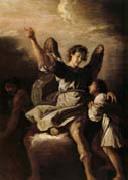 |
Fetti,Domenico
|
|
Italian painter , 1589-1623
was an Italian Baroque painter active mainly in Rome, Mantua and Venice. Born in Rome to a little-known painter, Pietro Fetti, Domenico is said to have apprenticed initially under Ludovico Cigoli, or his pupil Andrea Commodi in Rome from circa 1604-1613. He then worked in Mantua from 1613 to 1622, patronized by the Cardinal, later Duke Ferdinando I Gonzaga. In the Ducal Palace, he painted the Miracle of the Loaves and Fishes. The series of representations of New Testament parables he carried out for his patron's studiolo gave rise to a popular specialty, and he and his studio often repeated his compositions. In August or September 1622, his feuds with some prominent Mantuans led him to move to Venice, which for the first few decades of the seventeenth century had persisted in sponsoring Mannerist styles (epitomized by Palma the Younger and the successors of Tintoretto and Veronese). Into this mix, in the 1620s-C30s, three "foreigners" Fetti and his younger contemporaries Bernardo Strozzi and Jan Lysebreathed the first influences of Roman Baroque style. |
|
|
|
|
|
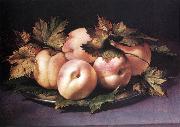 |
FIGINO, Giovanni Ambrogio
|
|
Italian painter, Lombard school (b. ca. 1551, Milano, d. 1608, Milano)
was an Italian Renaissance painter from Milan. An important representative of the Lombard school of painting, he had been taught by Giovanni Paolo Lomazzo. Best known as a draftsman, he was also a skilled portrait painter. Among the few portraits that can be traced back to Figino, the portrait of Field Marshal Lucio Foppa is one of the best known. On January 25, 2001, his Portrait of Giovanni Angelo was auctioned at Sotheby's for US$ $1,435,750; after a high estimate of US$ 180,000[1]. The organ shutters for the Cathedral of Milan were painted after 1590 by Ambrogio, Camillo Procaccini, and Giuseppe Meda, depicting the Passage of the Red Sea and the Ascencion of Christ. In the Castello Sforcesco there is a painting of his of Saint Ambrose expelling the Arians. A still life painting, a thematic uncommon among Italians of his day, of peaches is attributed to him He also painted in Milan an Immaculate conception for Sant'Antonio, |
|
|
|
|
|
 |
Filippino Lippi
|
|
Italian
1457-1504
Filippino Lippi Galleries
Born Filippo Lippi in Prato (Tuscany), the illegitimate son of the painter Fra Filippo Lippi and nun Lucrezia Buti, Filippino first trained under his father. They moved to Spoleto, where Filippino served as shop adjuvant in the construction of the Cathedral there. When his father died in 1469, he completed the frescos with Storie della Vergine (Histories of the Virgin) in the cathedral. Filippino Lippi completed his apprenticeship in the workshop of Botticelli, who had been a pupil of Filippino's father. In 1472, Botticelli also took him as his companion in the Compagnia di San Luca.
His first works greatly resemble those of Botticelli's, but with less sensitivity and subtlety. The very first ones (dating from 1475 onwards) were initially attributed to an anonymous "Amico di Sandro" ("Friend of Botticelli"). Eventually Lippi's style evolved into a more personal and effective one in the years 1480-1485. Works of the early period include: the Madonnas of Berlin, London and Washington, the Journeys of Tobia of the Galleria Sabauda in Turin, Italy, the Madonna of the Sea of Galleria dell'Accademia and the Histories of Ester.
Together with Perugino, Ghirlandaio and Botticelli, Lippi worked on the frescoed decoration of Lorenzo de Medici's villa at Spedaletto. On December 31, 1482 he was commissioned to work on a wall of Sala dell'Udienza of Palazzo Vecchio in Florence (a work never begun). Soon after (probably in 1483-1484) he was called to complete Masaccio's decoration of Brancacci Chapel in the church of the Carmine, left unfinished by the artist's death in 1428 . Here he realized the Stories of Saint Peter on the following frescoes: Quarrel with Simon Magus in face of Nero, Resurrection of Teophilus' Son, Saint Peter Jailed, Liberation and Saint Peter's Crucifixion.
The work on the Sala degli Otto di Pratica, in the Palazzo Vecchio, started on February 20, 1486. It is now in the Uffizi Gallery. In the same years Piero di Francesco del Pugliese asked him to paint the altarpiece with Apparition of the Virgin to St. Bernard, now in the Badia Fiorentina, Florence. This is Lippi's most popular picture: a composition of unreal items, with its very particular elongated figures, backed by a phantasmagorical scenario of rocks and almost anthropomorphic trunks. The work can be dated to the 1480-1486 years.
Eventually he worked for Tanai de' Nerli in the Saint Spirit's Church.
On April 21, 1487, Filippo Strozzi asked him to decorate the family chapel in Santa Maria Novella with the Stories of St. John Evangelist and St. Philip. He worked on this piece intermittently, only completing it in 1503, after the customer's death. The windows with musical themes, also designed by Filippino, were completed between June and July 1503. These paintings can be seen as a mirror of the political and religious crisis in Florence at the time: the theme of the fresco, the clash between Christianity and Paganism, was hotly debated in the Florence of Girolamo Savonarola.
Filippino showed his characters in a landscape which recreated the ancient world in its finest details, showing the influence of the Grottesco style he had seen in his journey to Rome. He created in this way an "animated", mysterious, fantastic but also disquieting style, showing the unreality of something as a nightmare. In this way, Filippino portrayed ruthless executioners deformed by grim faces, who raged against the Saints. In the scene with St. Philip expelling a monster from the temple, the statue of the pagan god is a living figure which seems to dare the Christian saint.
In 1488, Lippi moved to Rome, where Lorenzo de' Medici had advised Cardinal Oliviero Carafa to entrust him the decoration of the family chapel in Santa Maria sopra Minerva. These frescoes show a new kind of inspiration, quite different from the earlier works, but confirm his continued research on the themes of the Ancient era. Lippi finished the cycle by 1493.
Lippi's return to Florence is variously assigned to the years going from 1491 to 1494 . Works of this period include: Apparition of Christ to Madonna (1493, now in Munich), Adoration of the Magi (1496, for the church of San Donato in Scopeto, now in the Uffizi), Sacrifice of Lacoön (end of the century, for the villa of Lorenzo de' Medici at Poggio a Caiano), St. John Baptist and Maddalena (Valori Chapel in San Procolo, Florence, inspired in some way to Luca Signorelli's art). He also worked outside of his mother-country, namely on the Certosa of Pavia and in Prato, where in 1503 he completed the Tabernacle of the Christmas Song, now in the City Museum; in 1501 Lippi realized the Mystic Wedding of St. Catherine for the Basilica of San Domenico in Bologna.
Lippi's last work is the Deposition for the Santissima Annunziata church in Florence, which at his death in April 1504 was unfinished.
He was so renowned that all the workshops of the city closed on the day of his burial. |
|
|
|
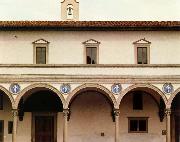 |
Filippo Brunelleschi
|
|
Italian Early Renaissance Sculptor and Architect, 1377-1446,Florentine architect and engineer. Trained as a sculptor and goldsmith, he turned his attention to architecture after failing to win a competition for the bronze doors of the Baptistery of Florence, having tied with Lorenzo Ghiberti. He worked out the laws of linear perspective (later codified by Leon Battista Alberti). By the early 1420s Brunelleschi was Florence's most prominent architect. His major work, the octagonal dome of the cathedral (1420 ?C 36), was constructed with the aid of machines of his own invention. The Medici family commissioned him to design the (old) sacristy and basilica of San Lorenzo (begun 1421), considered keystones of the early Renaissance; he adhered to the conventional format while adding his own interpretation of antique designs for capitals, friezes, pilasters, and columns. His later monumental works foreshadowed the strong profiles and massive grandeur of the work of Alberti and Donato Bramante. |
|
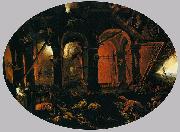 |
Filippo Napoletano
|
|
(c. 1587 - November 1629) was an Italian artist, with a peculiar output, mainly landscape and genre scenes and also drawings or etchings of diverse, often particular, items such as exotic soldiers, skeletons of animals, or cityscapes.
He began his career in his native city, Naples (1600-1613) and moved to Rome in 1614-1617), where he appears to have encountered and felt influenced by the successful Flemish landscape painters such as Paul Bril, Goffredo Wals, and Adam Elsheimer.
In 1617 Cosimo II dee Medici summoned him to Florence, where he worked closely with Jacques Callot. From notebooks, Filippo is known to have made hundreds of sketches of Tuscan landscapes and towns.
Starting in 1620 he reproduced in etchings part of his collection of animal skeletons owned by Johann Faber, a Bavarian physician-naturalist residing in Rome and a member of the scientific Accademia dei Lincei. In 1622, Napoletano published twelve etchings of caprices (capprici) and military uniforms (which he signed as signed Teodor Filippo de Liagno).
He is described by Giovanni Baglione as possessing a collection, a Wunderkammer of bellissime bizzarrie ("beautiful bizarre objects"), including among the objects exotic weaponry; fossilized plants; tiger, lion, and turtle skulls; oriental porcelain and sculpted crockery; a vest made of human skin; a harness for dragging whales on ice; a three-legged flea, Persian uniforms, and antiquities such as Roman coins, bronze lamps, and a few statuettes. After Napoletano death at Rome in 1628, bidding for such material was made by collectors such as Cardinal Ippolito Aldobrandini (future Clement VIII) and Cassiano dal Pozzo.
|
|
|
|
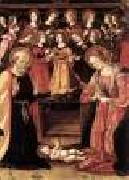 |
FIORENZO DI LORENZO
|
|
Italian painter, Umbrian school (b. ca. 1445, Perugia, d. ca. 1525, Perugia) |
|
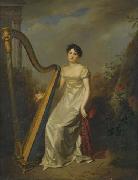 |
Firmin Massot
|
|
painted Portrait of a lady, wearing a white dress and seated beside a harp a landscape beyond in 1810 |
|
 |
Fisher Jonathan
|
|
American.
b.1768 d.1847
was the first Congregational minister from 1794 to 1837 in the small village of Blue Hill, Maine in the United States. Although his primary duties as a country parson engaged much of his time, Fisher was also a farmer, scientist, mathematician, surveyor, and writer of prose and poetry. He bound his own books, made buttons and hats, designed and built furniture, painted sleighs, was a reporter for the local newspaper, helped found Bangor Theological Seminary, dug wells, built his own home and raised a large family. Truly a renaissance man in the breadth of his accomplishments Fisher invites comparison with a Franklin or Jefferson. In his manners, morals and writings Fisher represents the best of the vigorous New England churchmen who shaped the standards of their congregations during America's formative years. |
|
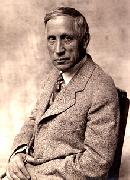 |
Fiske Warren
|
|
Frederick Fiske Warren (2 July 1862-2 February 1938) was a hugely successful Paper Manufacturer, fine arts denizen and major supporter of Henry George's Single Tax system which he helped develop in Harvard, Massachusetts, United States in the 1930's. He was the son of Samuel Dennis Warren and Susan Cornelia Warren of Beacon Hill, Boston, Massachusetts and the brother to Samuel D. Warren (US attorney) and Edward Perry Warren.
Born in Waltham, Massachusetts, Fiske was raised in a mansion on 67 Mount Vernon Street[1] in Beacon Hill, Boston, Massachusetts. A philanthropic and highly educated family, the Warren brothers and sisters all enjoyed tranquil childhoods growing up between the family homes in Boston and Waltham, Massachusetts, also known as "Cedar Hill".
|
|
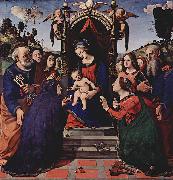 |
Fitz Henry Lane
|
|
(December 19, 1804 - August 14, 1865) was an American painter and printmaker of a style that would later be called Luminism, for its use of pervasive light.
Fitz Henry Lane was born on December 19, 1804, in Gloucester, Massachusetts. Lane was christened Nathaniel Rogers Lane on March 17, 1805, and would remain known as such until he was 27. It was not until March 13, 1832 that the state of Massachusetts would officially grant Lanees own formal request (made in a letter dated December 26, 1831) to change his name from Nathaniel Rogers to Fitz Henry Lane. As with practically all aspects of Lanees life, the subject of his name is one surrounded by much confusioneit was not until 2005 that historians discovered that they had been wrongly referring to the artist as Fitz Hugh, as opposed to his chosen Fitz Henry, and the reasons behind Lanees decision to change his name, and for choosing the name he did, are still very unclear.
|
|
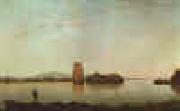 |
Fitz Hugh Lane
|
|
1804-1865
Fitz Henry Lane was born on December 19, 1804, in Gloucester, Massachusetts. Lane was christened Nathaniel Rogers Lane on March 17, 1805, and would remain known as such until he was 27. It was not until March 13, 1832 that the state of Massachusetts would officially grant Lane??s own formal request (made in a letter dated December 26, 1831) to change his name from Nathaniel Rogers to Fitz Henry Lane. As with practically all aspects of Lane??s life, the subject of his name is one surrounded by much confusion??it was not until 2005 that historians discovered that they had been wrongly referring to the artist as Fitz Hugh, as opposed to his chosen Fitz Henry, and the reasons behind Lane??s decision to change his name, and for choosing the name he did, are still very unclear.
From the time of his birth, Lane would be exposed to the sea and maritime life??a factor that obviously had a great impact his later choice of subject matter. Many circumstances of his young life ensured Lane??s constant interaction with various aspects of this maritime life, including the fact that Lane??s family lived ??upon the periphery of Gloucester Harbor??s working waterfront,?? , and that his father, Jonathan Dennison Lane, was a sailmaker, and quite possibly owned and ran a sail loft. It is often speculated that Lane would most likely have pursued some sea-faring career, or become a sail-maker like his father, instead of an artist, had it not been for a life-long handicap Lane developed as a child. Although the cause cannot be known with complete certainty, it is widely accepted most plausible that the ingestion of some part of the Peru-Apple??a poisonous weed also known as jimsonweed??by Lane at the age of eighteen months caused the paralysis of the legs from which Lane would never recover. It is suggested, and seems logical to assume, that because he could not play games as the other children did, he was forced to find some other means of amusement, and that in such a pursuit he discovered and was able to develop his talent for drawing. To go a step further, as a result of his having a busy sea-port as immediate surroundings, he was able to develop a special skill in depicting the goings-on inherent in such an environment.
It is true that Lane could still have become a sail-maker, as such an occupation entailed much time spent sitting and sewing, and that Lane already had some experience sewing from his short-lived apprenticeship in shoe-making. However, as evidenced in this quote from Lane??s nephew Edward Lane??s ??Early Recollections,?? his interest in art held much sway in his deciding on a career: ??Before he became an artist he worked for a short time making shoes, but after a while, seeing that he could draw pictures better than he could make shoes he went to Boston and took lessons in drawing and painting and became a marine artist.??
Lane acquired such ??lessons?? by way of his employment at Pendleton??s lithography shop in Boston, which lasted from 1832 to 1847. With the refinement and development of his artistic skills acquired during his years working as a lithographer, Lane was able to successfully produce marine paintings of high quality, as evidenced in his being listed, officially, as a ??marine painter?? in the Boston Almanac of 1840. Lane continued to refine his painting style, and consequently, the demand for his marine paintings increased as well.
Lane had visited Gloucester often while living in Boston, and in 1848, he returned permanently. In 1849, Lane began overseeing construction of a house/studio of his own design on Duncan??s Point??this house would remain his primary residence to the end of his life. Fitz Henry Lane continued to produce beautiful marine paintings and seascapes into his later years. He died in his home on Duncan??s Point on August 14, 1865, and is buried in Oak Grove Cemetery. |
|
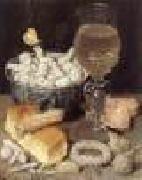 |
FLEGEL, Georg
|
|
German painter (b. 1566, Olomouc, d. 1638, Frankfurt am Main).
was a German painter, best known for his still life works. Flegel was born in Olmetz (Olomouc), Moravia. Around 1580 he moved to Vienna, where he became the assistant to Lucas van Valckenborch I, a painter and draughtsman. Flegel and his employer later moved to Frankfurt, which at the time was an important art-dealing city. As an assistant, he inserted items such as fruit, flowers, and table utensils into Valckenborch's works. In a period of about 30 years (c. 1600-1630), he produced 110 watercolor pictures, mostly still life images which often depicted tables set for meals and covered with food, flowers, and the occasional animal. |
|
|
|
|
|
|
|
|
|
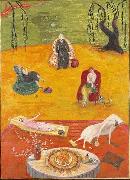 |
Florine Stettheimer
|
|
(August 29, 1871 - May 11, 1944) was an American artist. She has been described as "a Deco-influenced early Modernist whos never really gotten her due".
Florine was born in Rochester, New York to Joseph Stettheimer and Rosetta Walter. Her father, a banker, left the family before the children were grown. She was the fourth of five children: Walter, Stella, Carrie, Florine, and Ettie. After Walter and Stella married, the youngest three immured with their mother to form an epicurean way of life.She spent much of her early life traveling, studying art in Italy, Spain, France, Germany, and Switzerland. She studied for three years in the mid-1890s at the Art Students League of New York, but came into her own artistically upon her permanent return to New York after the start of World War I. In October 1916, the only one-person exhibition of her work during her lifetime took place at New York's Knoedler & Company. She exhibited 12 "high-keyed, decorative paintings", none of which were sold.
Cushioned by family resources, Stettheimer refrained from self-promotion and considered her painting "an entirely private pursuit". She intended to have her works destroyed after her death, a wish defied by her sister Ettie, her executor.
Stettheimer's privileged position pervades her work. As one critic has written, "money she regarded as a birthright, decidedly not something to be flaunted in the shape of a dozen yachts, but rather to be used as a palliative against the more unpleasant aspects of the world outside... In this frame of mind, she felt free to depict life as a series of boating parties, picnics, summertime naps, parades and strolls down Fifth Avenue."
She created the sets and costumes for the 1934 production of Four Saints in Three Acts, an opera by Virgil Thomson with a libretto by Gertrude Stein. Her designs, which used cellophane in innovative ways, proved to be the project for which she was best known during her lifetime.
She assisted her sister Carrie in the creation of the Stettheimer Dollhouse, now in the collection of the Museum of the City of New York. The house is a whimsical depiction of an upper-class residence, filled with works by Stettheimer's artist friends, including William Zorach, Alexander Archipenko, and Gaston Lachaise. |
|
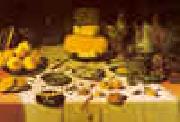 |
Floris van Dijck
|
|
Dutch Baroque Era Painter, 1575-1651
Dutch painter and draughtsman. He is thought to have been a pupil of Rembrandt in Amsterdam c. 1650. There is no documentary evidence for this, but his earliest dated painting, the Presentation in the Temple shows that he had certainly seen examples of Rembrandt work. He was an eclectic artist, given to following several models simultaneously. This is evident from two versions of Elijah and the Widow of Zarephath; one (1655-60; Copenhagen, Stat. Mus. Kst) is painted in horizontal format in the style of Barent Fabritius, while the other (1655-60; Milwaukee, WI, A. Bader priv. col., see Sumowski, 1983, no. 362) features large half-length figures in the manner of Nicolaes Maes. In another biblical scene, Benjamin and Judah (1655-60; Chicago, IL, A. Inst.), he followed the example of Rembrandt. His best works, such as Saying Grace (1655-60; Hannover, Nieders?chs. Landesmus.) and the Old Prophetess (1655-60; Leipzig, Mus. Bild. Kst), show old women either praying or sleeping and confirm that Maes was his main source of inspiration. Similar subjects are represented in the drawings attributed to him (e.g. Old Woman Seated, Holding a Book; New York, Pierpont Morgan Lib.). In the late 1650s van Dijck also seems to have been influenced by the genre paintings of Gabriel Metsu and above all by Quiringh van Brekelenkam, as in Hermit Praying in a Cave (late 1650s; St Petersburg, Hermitage) and Family Saying Grace (late 1650s; Stockholm, Nmus.). |
|
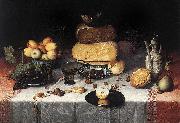 |
Floris van Dyck
|
|
, also called Floris van Dijck or Floris Claesz. van Dyck (Delft or Haarlem, c. 1575 - Haarlem, before 26 April 1651), was a Dutch Golden Age still life painter.
He lived in Haarlem for most of his life, but he was born in Delft. He was a cousin of Pieter Cornelisz van Dijck. In 1600 he is documented as being in Rome, indicating he made a journey to Italy. In 1606 he returned to the Netherlands, where he joined the Haarlem Guild of St. Luke in 1610 and became dean in 1637. He was influenced by Osias Beert and Clara Peeters. He is considered the inventor of the banketje (banquet still life genre similar to breakfasts, or ontbijtjes), together with Nicolaes Gillis. |
|
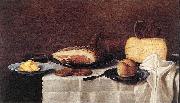 |
Floris van Schooten
|
|
(1590-1655), was a Dutch Golden Age still life painter.
According to the RKD, Van Schooten was the son of a leading Catholic family of Amsterdam who came to live in Haarlem in 1612. During that period, many Catholic families left Amsterdam where the Protestants had the upper hand in local government, for Haarlem, where the climate for Catholicism was more tolerant. The young Van Schooten became a member of the Haarlem Guild of St. Luke and married the daughter of a leading beer brewer there, Rycklant Bol van Zanen. Together they had 3 daughters and a son Johannes, who also became a painter |
|
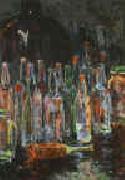 |
Floris Verster
|
|
1861-1927
Dutch
Floris Verster Gallery
Dutch painter. He trained first at the Ars Aemula Naturae school in Leiden under George Hendrik Breitner, then at The Hague Academie (1879-82) and the Brussels Academie (1882). In Leiden in 1882 he started painting landscapes in the style of the Hague school. From 1882 to 1892 he shared a studio in Leiden with the still-life painter Menso Kamerlingh Onnes (1860-1925), who was to become his brother-in-law. Influenced by Onnes and such French realists as Antoine Vollon and Theodule Ribot, in 1885 he turned to painting still-lifes in a mildly Impressionist style that by 1888-9 often attained monumental formats, as in Peonies (1.35*2.00 m, 1889; Amsterdam, Stedel. Mus.). He submitted some of these to exhibitions, where their reception was mixed; artists including Breitner, H. W. Mesdag and Jacob Maris were enthusiastic, but the critics quite often were not. He participated in a few exhibitions abroad, notably from 1890 to 1894 in Munich and in 1891 with Les XX in Brussels. |
|
|
|
|
|
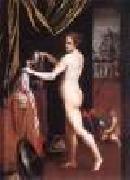 |
FONTANA, Lavinia
|
|
Italian Painter, 1552-1614
Daughter of Prospero Fontana. She was trained by her father and followed his Mannerist style. Her first recorded works, which date from 1575, were small paintings for private devotion, such as the Holy Family (Dresden, Gemeldegal.). By 1577 she had become established as a portrait painter in Bologna. Works of this date include the Self-portrait at the Harpsichord (Rome, Gal. Accad. S Luca) and the portrait of Senator Orsini (Bordeaux, Mus. B.-A.). Her portrait style reflects the formality of central Italian models as well as the naturalistic tendencies of the north Italian tradition. The elegantly costumed Orsini is shown seated at a table, with a suite of rooms opening behind him, a setting recalling such Florentine portraits of the 1530s as Agnolo Bronzino's Bartolommeo Panciatichi (Florence, Uffizi). Lavinia used a similar setting for other portraits, including the Gozzadini Family (1584; Bologna, Pin. N.). Female sitters are also shown in elaborate dress, with particular attention paid to details of embroidery and jewels, and they are often accompanied by small dogs |
|
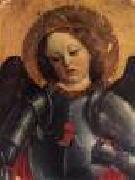 |
FOPPA, Vincenzo
|
|
Italian Early Renaissance Painter, ca.1430-1515
was a Northern-Italian Renaissance painter. He was an elderly contemporary of Leonardo da Vinci. Born at Bagnolo Mella, near Brescia in the Republic of Venice, he settled in Pavia around 1456, serving the dukes of Milan and emerging as one of the most prominent Lombard painters. Foppa returned to Brescia in 1489. His style shows affinities to Andrea del Castagno and Carlo Crivelli. Vasari claimed he had trained in Padua, where he may have been strongly influenced by Mantegna. During his lifetime, he was highly acclaimed, especially for his skill in perspective and foreshortening. His important works include a fresco in the Brera Gallery of Milan, the Martyrdom of St. Sebastian, and a Crucifixion (1435) in the Accademia Carrara of Bergamo. Many of his works have been lost. He was influential in the styles of Vincenzo Civerchio and Girolamo Romanino.
|
|
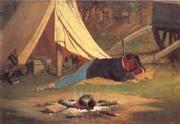 |
Forbes, Edwin
|
|
1839-1895 ,was an American landscape painter and etcher who first gained fame during the American Civil War for his detailed and dramatic sketches of military subjects, including battlefield combat scenes. Forbes was born in New York, studied under A. F. Tait, and began as an animal and landscape painter. During the Civil War, he was special artist for Frank Leslie Magazine. Many of the spirited etchings he drew during the conflict were later presented by General Sherman to the government. They are now preserved in the War Office at Washington because of their historic value. After the war, Forbes painted landscape and cattle scenes, among which are Orange County Pasture (1879) and Evening??Sheep Pasture (1881). In 1877 he was made an honorary member of the London Etching Club. He died in 1895 in Brooklyn and is buried in Green-Wood Cemetery. |
|
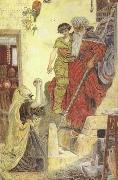 |
Ford Madox Brown
|
|
1821-1893
English painter and designer. The son of a retired ship's purser who had settled at Calais, Brown received an academic training under Albert Gregorius (1774-1853) at Bruges, under Pieter van Hanselaere (1786-1862) at Ghent and under Baron Gustaf Wappers at the Academie in Antwerp (1837-9). He moved to Paris in 1840, married the following year and studied independently of the ateliers |
|
|

